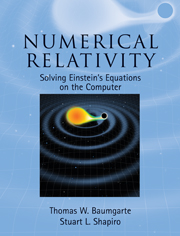Book contents
- Frontmatter
- Contents
- Preface
- Suggestions for using this book
- 1 General relativity preliminaries
- 2 The 3 + 1 decompostion of Einstein's equations
- 3 Constructing initial data
- 4 Choosing coordinates: the lapse and shift
- 5 Matter sources
- 6 Numerical methods
- 7 Locating black hole horizons
- 8 Spherically symmetric spacetimes
- 9 Gravitational waves
- 10 Collapse of collisionless clusters in axisymmetry
- 11 Recasting the evolution equations
- 12 Binary black hole initial data
- 13 Binary black hole evolution
- 14 Rotating stars
- 15 Binary neutron star initial data
- 16 Binary neutron star evolution
- 17 Binary black hole–neutron stars: initial data and evolution
- 18 Epilogue
- A Lie derivatives, Killing vectors, and tensor densities
- B Solving the vector Laplacian
- C The surface element on the apparent horizon
- D Scalar, vector and tensor spherical harmonics
- E Post-Newtonian results
- F Collisionless matter evolution in axisymmetry: basic equations
- G Rotating equilibria: gravitational field equations
- H Moving puncture representions of Schwarzschild: analytical results
- I Binary black hole puncture simulations as test problems
- References
- Index
9 - Gravitational waves
Published online by Cambridge University Press: 05 March 2013
- Frontmatter
- Contents
- Preface
- Suggestions for using this book
- 1 General relativity preliminaries
- 2 The 3 + 1 decompostion of Einstein's equations
- 3 Constructing initial data
- 4 Choosing coordinates: the lapse and shift
- 5 Matter sources
- 6 Numerical methods
- 7 Locating black hole horizons
- 8 Spherically symmetric spacetimes
- 9 Gravitational waves
- 10 Collapse of collisionless clusters in axisymmetry
- 11 Recasting the evolution equations
- 12 Binary black hole initial data
- 13 Binary black hole evolution
- 14 Rotating stars
- 15 Binary neutron star initial data
- 16 Binary neutron star evolution
- 17 Binary black hole–neutron stars: initial data and evolution
- 18 Epilogue
- A Lie derivatives, Killing vectors, and tensor densities
- B Solving the vector Laplacian
- C The surface element on the apparent horizon
- D Scalar, vector and tensor spherical harmonics
- E Post-Newtonian results
- F Collisionless matter evolution in axisymmetry: basic equations
- G Rotating equilibria: gravitational field equations
- H Moving puncture representions of Schwarzschild: analytical results
- I Binary black hole puncture simulations as test problems
- References
- Index
Summary
Spherically symmetric spacetimes, which we discussed in Chapter 8, do not admit gravitational radiation. Once we relax this symmetry restriction, as we shall do in the following chapters, we will encounter spacetimes that do contain gravitational radiation. In fact, simulating promising sources of gravitational radiation and predicting their gravitational wave signals are among the most important goals of numerical relativity. These goals are especially urgent in light of the new generation of gravitational wave laser interferometers which are now operational. A book on numerical relativity therefore would not be complete without a discussion of gravitational waves.
In this chapter we review several topics related to gravitational waves. We start in Section 9.1 with a discussion of linearized waves propagating in nearly Minkowski spacetimes and the role that these waves play even in the case of nonlinear sources of gravitational radiation. In Section 9.2 we survey plausible sources of gravitational waves, highlighting those that seem most promising from the perspective of gravitational wave detection. We briefly describe some of the existing and planned gravitational wave detectors in Section 9.3. Finally, in Section 9.4 we make contact with numerical relativity, and review different strategies that have been employed to extract gravitational radiation data from numerical relativity simulations.
Linearized waves
Most of this book deals with strong-field solutions of Einstein's equations, including black holes, neutron stars, and binaries containing these objects. As long as these solutions are dynamical and nonspherical, they will emit gravitational radiation.
- Type
- Chapter
- Information
- Numerical RelativitySolving Einstein's Equations on the Computer, pp. 311 - 351Publisher: Cambridge University PressPrint publication year: 2010



